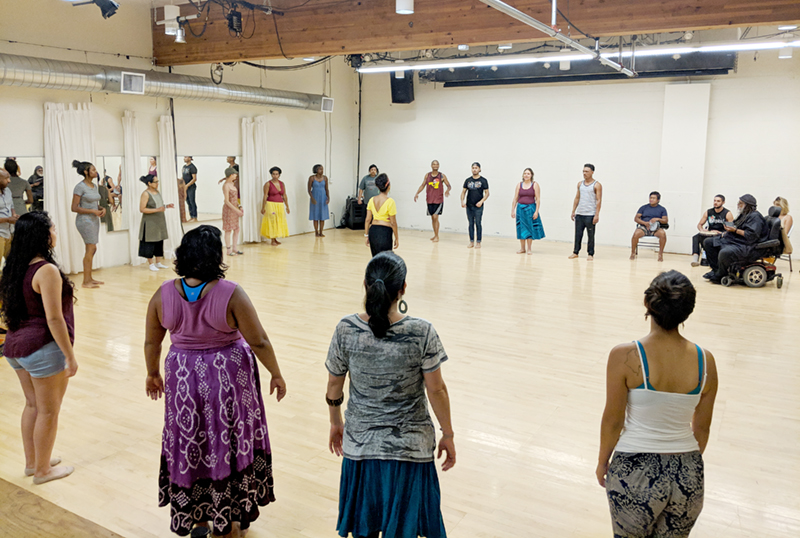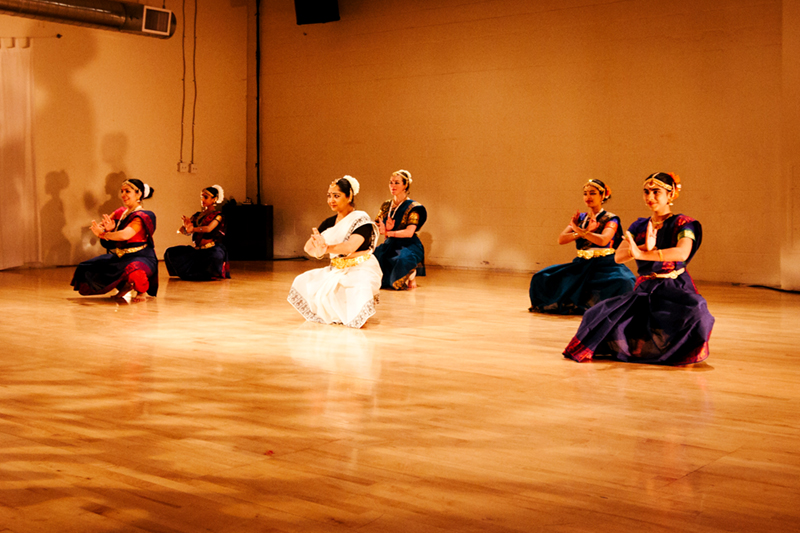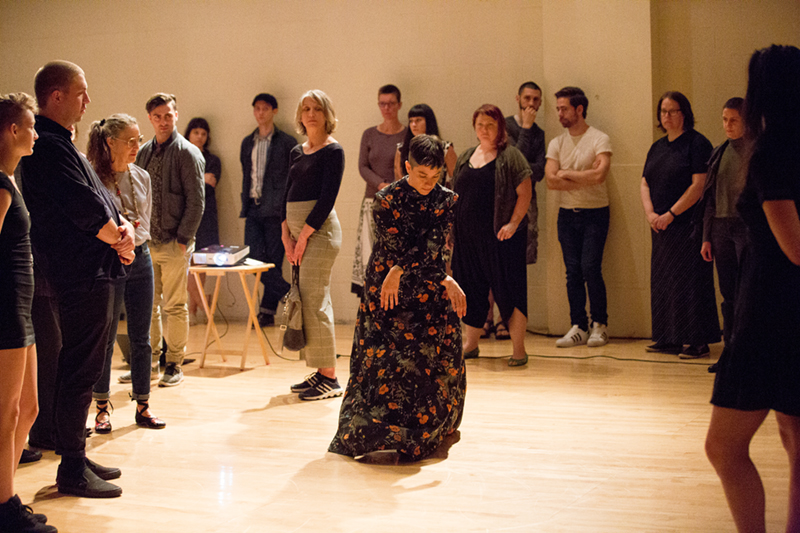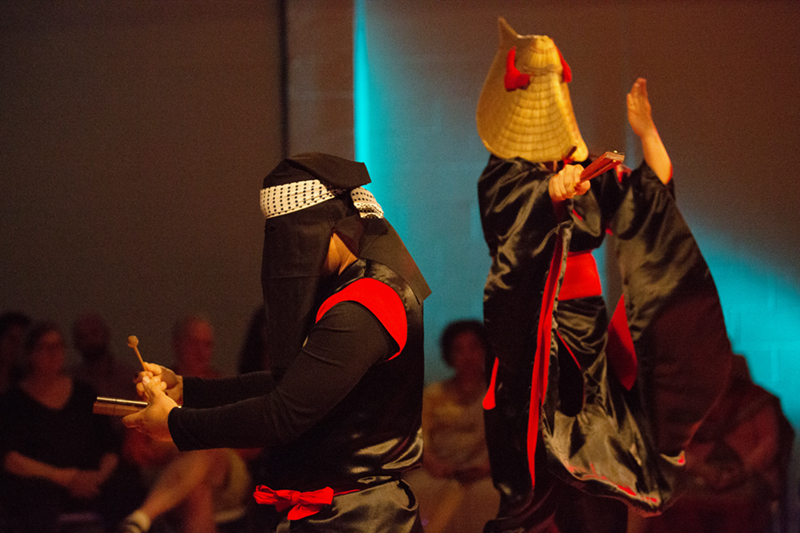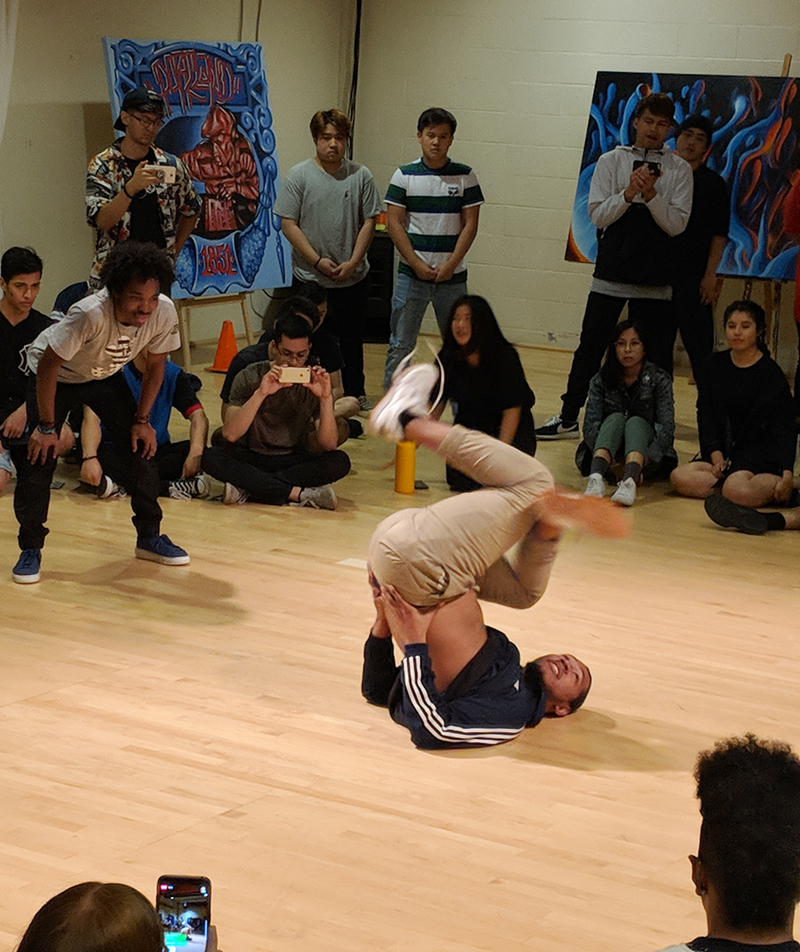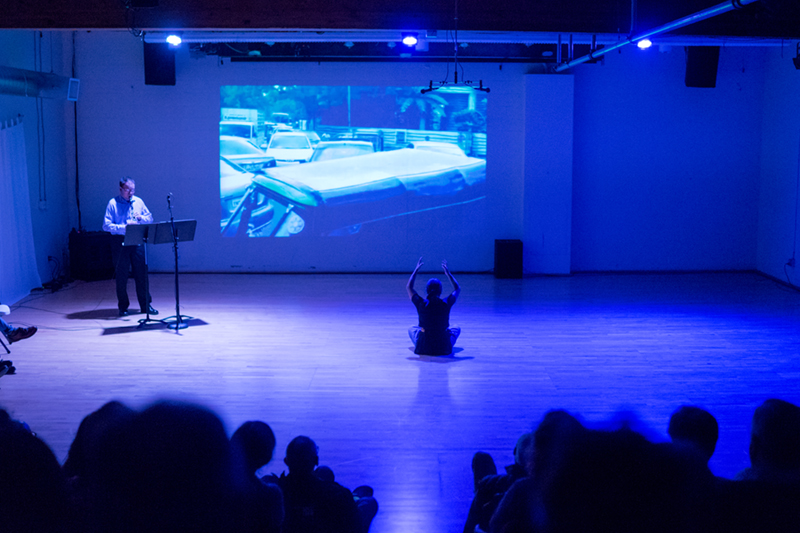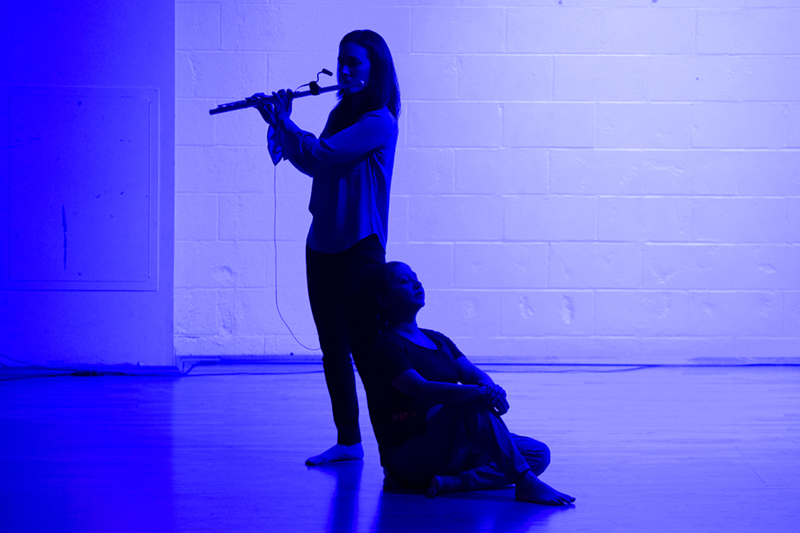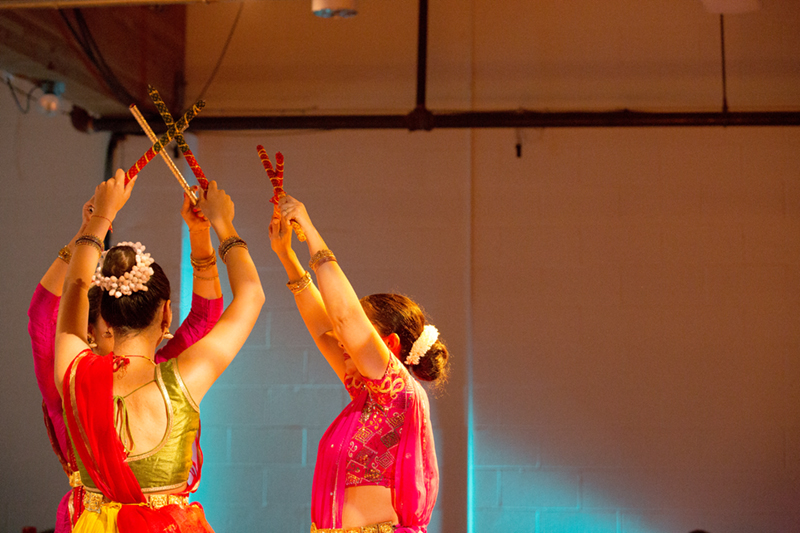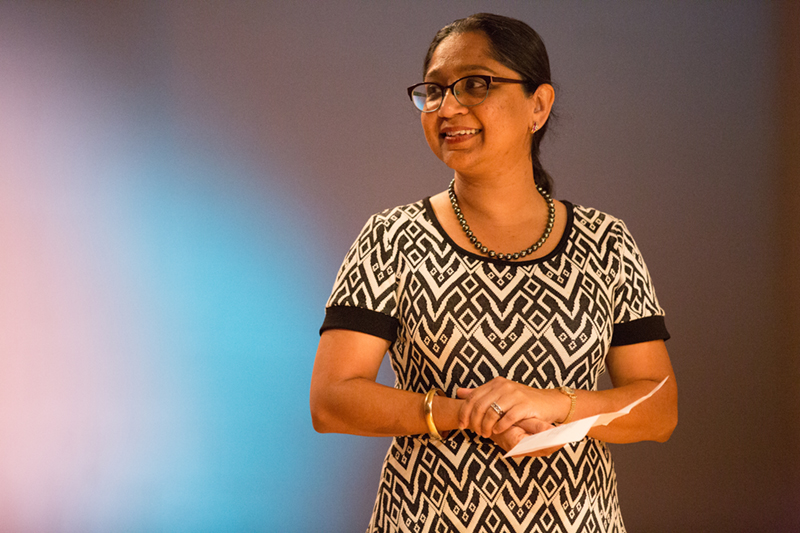Building an Accessible Space
An Interview with Subashini Ganesan
BY EMMALY WIEDERHOLT
Subashini Ganesan is an artist, arts administrator and the Creative Laureate of Portland, OR. She founded Natya Leela Academy, where she choreographs and performs in Bharatanatyam. She is also founder and executive director of New Expressive Works (N.E.W.), a vibrant performing arts venue that celebrates and supports multicultural independent performing artists to teach, be in residency, and create new works. Here, she discusses the impetus and philosophy behind N.E.W. and how she has built an accessible performing art space.
~~
Can you tell me a little about your own dance history – what kinds of performance practices and in what contexts shaped who you are today?
I started learning Bharatanatyam, a classical Indian dance form from Tamil Nadu (an Indian state), when I was four and a half. I was born and raised in Singapore, a multicultural country with a population that is 76 percent Chinese, 15 percent Malays, 7.4 percent Indians, and small percentages of other nationalities. Being in that environment, I studied Bharatanatyam with a teacher who taught us more than the intricate fundamentals, techniques, and traditions of the art form. From an early age I was exposed to learning and dancing her choreographies that included collaborations with dancers, poets, and musicians from all the cultural forms available in Singapore. So I would say that, from the beginning, I was learning both the integrity of my art form and what could be explored in relationship with our current contemporary world.
I moved to the United States to go to college in Rochester, NY, then lived in Washington, DC, working in public policy initiatives, and finally moved to Portland in 2001. I dabbled in swing dance and, in 2003, entered a serious immersive period into Argentine tango. Throughout that time, I continued performing Bharatanatyam and presenting small, original choreographies whenever I could. In 2008, I saw clearly that I had to accept that dance (especially my foundational form of Bharatanatyam) is my oxygen. I started a dance school in Portland and began teaching and choreographing without diversions. In my desire to bring Bharatanatyam to more audiences in Portland and beyond, I became a teaching artist through Young Audiences and the Right Brain Initiative. Both organizations focus on integrating multidisciplinary arts into regional public and private schools. This allowed me to become comfortable in walking into classrooms and teaching Bharatanatyam to diverse ages and backgrounds. My work in schools continues to create new opportunities for me to bring my dance form to so many local and regional venues, including public libraries, universities and community events.
My first project grant was from the Regional Arts and Culture Council in 2011 to create and present a new work, Devoted. I created this work on my troupe with guest performer Jamuna Chiarini and in close collaboration with Michelle Fujii, a local Taiko artist, Japanese folk dancer, and co-artistic director of UNIT SOUZOU. In 2013, I created and performed a mostly solo show called Al(l)one – a work that examined the concepts behind the words ‘alone’ and ‘lonely.’ I continue to create new works that explore ways to stretch Bharatanatyam vocabulary (Bliss and Other Easy Things in 2017 and Traces of Essence in 2018) while collaborating with a variety of artists and arts organizations including Mike Barber, UNIT SOUZOU, Third Angle New Music and Ten Tiny Dances.
Photo by Cameron Oosley
What was the impetus behind starting New Expressive Works?
In 2010, I began renting a 450 sq. ft. studio in a building that was originally started by Carole Zoom, an activist in arts and disability rights, who wanted to provide artists affordable space to make and present work. In 2012, the contemporary dance group that was running the large (2,000 sq. ft.) performance space had to disband and asked me if I wanted to take it over. I said, “Okay, why not?”
I was beginning to know the dance community in Portland and noticed how contemporary and Western art forms were dominantly visible in media and in the eyes of the general dance audiences. As word got out that I was taking over the space, I was genuinely surprised by the initial outcry from several local contemporary dancers and dance professionals. Some of them even commented to me that they hoped I wouldn’t convert the space into a yoga studio. I remember responding to one of them, “What South Asian opens a yoga studio in Portland?” It was a curious beginning.
In any case, I met with several willing leaders of the Portland contemporary dance world and did a survey of what they thought was missing in our city, as I didn’t want to duplicate what I offered. Almost everyone said that there were not enough opportunities for choreographers of all levels to have safe spaces to create new works without having to self-fund the entire project. So, I decided to start a residency program in October 2012, and called it the “New Expressive Works” residency program.
Annually, eight choreographers receive six months of incubation space to develop new work of up to 20 minutes, a modest stipend, and a fully produced weekend performance opportunity. They also participate in three Fieldwork sessions where peers come together to witness each other’s work and provide critical thinking on what they are seeing.
Photo by Intisar Abioto
Right now, we’re in our 12th cycle of the residency program. All our residents thus far are local choreographers because we do not yet have the funds to house visiting artists. As of 2019, N.E.W.’s residency program will have supported 48 choreographers and over 150 of their collaborators (dancers, costume designers, sound engineers, composers, technical support staff, etc.).
The vision of the N.E.W. residency is to celebrate and highlight choreographers across cultures, genres and dance disciplines. This way we do not become myopic in our support of artists and are always striving to lift the voices and creations of diverse dance professionals. Contemporary Bharatanatyam, house, hip-hop, Native, and African choreographers work side-by-side with Western, modern, and post-modern dance-makers. By keeping the genres fluid within each residency cohort, I have seen dancers come together and truly speak to one another, beginning dialogues that lead to relationships across different movement vocabularies and philosophies.
I would say that the residency program inaugurated N.E.W. as an organization. But when affordable space began to get scarce in Portland, at the end of 2013, I started to pay attention to what else I could offer. Slowly, since I was the only person running all aspects of the space, I systematically built an affordable performance venue rental schedule for dance, music and theater artists to showcase their new works. I began collaborating with local organizations like the Portland Institute for Contemporary Art (PICA), Portland Art Museum, and Asian Pacific American Network Organization of Oregon (APANO) to welcome more artists into N.E.W. Most recently, I launched a program called “Our Cultural Voices,” an event series singularly focused on engaging diverse audiences to hear, see, feel and experience the identities and stories of artists and activists from under-represented and under-served communities. Presenters include people of color (especially Black, Latinx, and Asian communities), refugees, immigrants, LGBTQ activists, and disability activists.
Photo by Intisar Abioto
On the website, it lists the goals of N.E.W. as 1) make all cultural genres equally visible, 2) highlight the excellence of different artistic processes, and 3) maintain fully accessible practice and performances spaces. How have you tackled each of those goals?
I continue to have discussions with dancers and choreographers, nationally, who have a very narrow idea about the training one should receive in dance. In essence, they often expect someone who is pursuing and has successfully completed a BFA/MFA /something comparable to these collegial norms. I observe that among many Western practitioners, there is a perception that global dance forms, such as mine that have a lineage-based transmission, aren’t considered as intellectually rigorous but a mere extension of preserving traditional arts and culture.
In this environment, I decided from inception that N.E.W. must be a space for relationship-building among culturally diverse artistic professionalism and process. This, I believe, provides equity of space for practitioners and doesn’t elevate any particular type of art form.
How does this play out in daily practice in a venue like N.E.W., which is made up of two studios that share a wall and a common lobby? I’ll give you some scenarios. On Saturday mornings I am teaching Bharatanatyam to young kids in one studio while tai chi practitioners are leaving and an adult contemporary dance class begins in the other studio. On a Tuesday evening, a local independent theater group might be loading into one studio while capoeira practitioners are training in the other. On Wednesdays, adult Argentine tango lessons occur right next door to multi-generational kendo practice. Often, Ghanaian dancers and drummers might be rehearsing while a string quartet is setting up next door for a later evening performance. The company members of the Disability Arts and Culture Project might be practicing for their annual performance while an orientation for teaching artists is also occurring. A professional DJ spins for a national hip hop/b-boy/b-girl battle and cypher event while costume designers and choreographers are meeting to make plans for their upcoming performance. You get the picture, right?
How does this build equity of space? My philosophy has always been that diversity of activity in any one given space slowly creates conversation among artists and students, which eventually leads to bridge-building and relationships. Any new space user always gets a thorough orientation of N.E.W.’s philosophy that we are community centered, which means everyone has as much flexibility as responsibility. Starting and ending sessions on time is rigorously enforced so that no one gets short-changed. Anything brought into the space (performance props, for example) need to be cleared into designated storage areas at the end of sessions so that studios are always fully accessible for all N.E.W. community members. Exceptions are rare and only offered after I communicate with the entire community. Most importantly, no one (including myself as the founder and steward of N.E.W.) gets special treatment.
The foundational principal is that if we can all respect each other as equally professional artists, we then take care of the space in such a way that all of us can practice our art forms without feeling encumbered or intruded upon. To exist as a cohesive community, we need to acknowledge that our own needs cannot always come first. Basically, expectations around time-sensitivity, space maintenance, and willingness to have conversations about how we exist as a community center all of us around this principal.
With regards to creating fully accessible performance spaces, are you referring to economic access or disability access? In either case, how has creating those access points shaped the use of the space?
I’m lucky to have had two mentors in the world of physical disabilities. One is Carol Zoom who started the space. She taught me what it means to create a space that is physically accessible. The other is Kathy Coleman, who founded and runs the Disability Art and Culture Project and has been a vital member of N.E.W. since 2011. When I think of physical accessibility, I think of lockbox access for wheelchair users, no carpets in the lobby, permanent ramps going in and out of the building, language about low or no fragrance policy in all contracts with potential space users, and accessible performance seating, restrooms, greenrooms, sound-board and lighting-board area. The basic rule is this: The space is always accessible and we are always willing to learn about how we can improve.
The second thing is monetary access. The space is as affordable as it can be for what it provides, and is subsidized by grants, donors and my own work teaching and performing. The max someone is going to spend during a high peak night for rehearsals in a 2,000 sq. ft. sprung wood floor studio, with temperature control and high building security, is $18 an hour. I’m not providing a $9 or $8 per hour rental, but I can’t. I’m transparent about why the costs are the way they are. If need be, I sometimes work out plans. Since 2012, I can confidently say every single space user has been responsible. I’ve never had to chase anyone down so that I can collect payments. With independent artists, we all know what it takes and we really look out for each other.
Photo by Jason Wade
The third access I want to mention is what I think of as cultural access. The work space is neutral – no photos, texts, icons or paintings. There’s nothing on the walls to create a specific identity to the space. You make it yours for the time you are in it and it is each renter’s responsibility to bring it back to neutrality. This means that the hip hop dancer does not enter a studio which has photos of ballet dancers on the walls. A theater artist is not entering a dance studio with ballet barres. A taiko drummer is not surrounded by symphonic orchestral instruments while they are practicing. A contemporary dancer is not working in a studio that is painted with cultural symbols from across the worlds. In these times when cultural safety seems to be threatened in certain arenas, building in a conscious goal to maintain cultural diversity while ensuring neutrality to assist transition time is essential. I strongly believe that the more I can make N.E.W. a safe space, then it will be a venue that ensures that artistic excellence is always shining.
When considering a residency applicant, what does ‘contemporary’ mean to you, especially in consideration of N.E.W.’s goal to include many cultural genres?
I’m working through the terms for myself now. I’ve been in several contexts with folks like me who are Indian dancers making new work and scholarship, and their sense is to call the work we do ‘experimental’ rather than ‘contemporary.’ ‘Contemporary’ immediately conjures Western contemporary dance. Among my peers and colleagues, the term ‘contemporary’ assumes you have gone and studied Western contemporary dance to some extent, taken that information, and then fused it with Indian classical dance forms.
However, I think of contemporary as ‘now’… what are we doing with our art forms now; how am I as a dancer speaking about our contemporary world and human condition? When I began to explore notions of experimental or contemporary work about 12 years ago, I found that I was pressuring myself to somehow catch up to current Western artistic processes. And then, about six years ago, I had a couple of significant conversations with other artists who have similar backgrounds as mine, and it was profound. I came to the realization that we just haven’t had (or given ourselves) enough time and space to make a real definition of what our contemporary voices are. I think we have been sub-consciously driven by the trajectory of Western modern dance philosophies that really have had more time and freedom to evolve and therefore have taken center-stage on defining concepts of ‘modern’ and ‘post-modern’ expressions. So I have entered a practice of slowing down so that I can breathe fully into the nuances of what contemporary practice looks like for me. I am giving ample time so that I can explore and tell my stories at the speed they deserve.
Photo by Jason Wade
How has N.E.W. avoided the fate of so many other dance spaces with the rising cost of real estate in a city like Portland?
The honest truth is not very sexy: I work my ass off. For the first few years, I wasn’t taking home a significant pay. I was working really hard to maintain the space and pay for what it needs. I incorporated N.E.W. as a non-profit because I realized this designation helps with significant grants and the individual donor base. I’ve learned how to be an administrator, donor relations person, fundraiser, program developer, etc. Even now, every month is its own situation, but I believe that I am able to keep going because of my relationships. My landlords and key donors know me intimately. I have found that it helps tremendously to let them know what success looks like for an arts organization, so there’s really a lot of time I dedicate to communication and sharing of information.
Also, I believe my very stubborn nature helps; I’m not going to say no to a certain role just because I hadn’t imagined myself in that role/job description. Some dancemakers panic when they have to take on new responsibilities and roles, especially administrative ones, because they worry that their artistic practice will suffer. There are clearly times in the past (and I am sure in the future) when I wasn’t making new work, but I continue to balance it all. Most importantly, in times of organizational strategic crunch, I create a timeline, ask myself what I minimally need to do artistically so as not to feel trapped by administrative duties, and follow that timeline. Personally, I have discovered that teaching classes and working with kids are absolutely essential to my artistic process.
There’s not a magic bullet or best practices, and who knows what will happen with the economy and real estate. My singular goal is to keep the mission and vision alive as long as I can or it is needed.
From your perspective, what responses or impacts in the community have come about from N.E.W. since it opened in 2012?
Between 2012 and 2014, we were serving 50 to 100 independent performing artists per year, including local and regional artists. In the past couple years, that’s gone up to 200. For the past seven years, N.E.W. has been honored to be the workshop venue for the annual Time-Based Art Festival that PICA produces every September. The national and international artists who come through our space often praise the space and many wish for a space like N.E.W. in their home bases. The other significant thing I see is that the diversity of artists who use the studios brings a huge cross-section of our local community together. These community members come in the form of students, workshop attendees, audience members, and visiting curators. Again, a majority of the community members find the space 100 percent suitable for their needs, and this reflects that N.E.W. is on the right path to staying on target with its mission and vision.
Photo by Intisar Abioto
Of course, the residency program has proven to be a very important thing. Veteran artists like Gregg Beielemier, Linda K. Johnson and Tere Mathern have used the residency to make new works. Emerging artists like Oluyinka Akinjiola and Shaun Keylock formed their dance companies during their residency and now are flourishing both in the local and national scene. Decimus Yarbrough and Michael Galen, both alums of the residency, keep gaining greater relationships in the arts community and are on their second year of producing an international event called the Cypher Culture Conference.
There are many positive stories that germinate and come to fruition at N.E.W. and I love watching them unfold. I truly believe that N.E.W. continues to be a space for artists and their collaborators to feel safe, make work, create connections, build relationships, and therefore find meaningful avenues for their art and humanity to blossom.
~~
To learn more, visit newexpressiveworks.org.
Subashini Ganesan, Photo by Intisar Abioto

